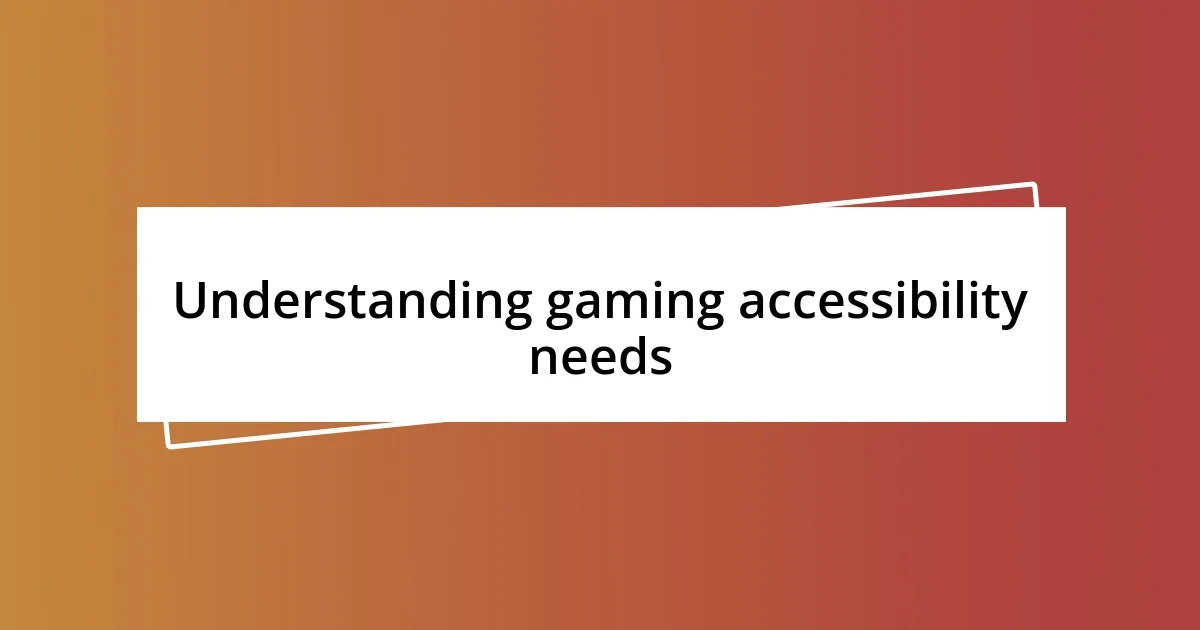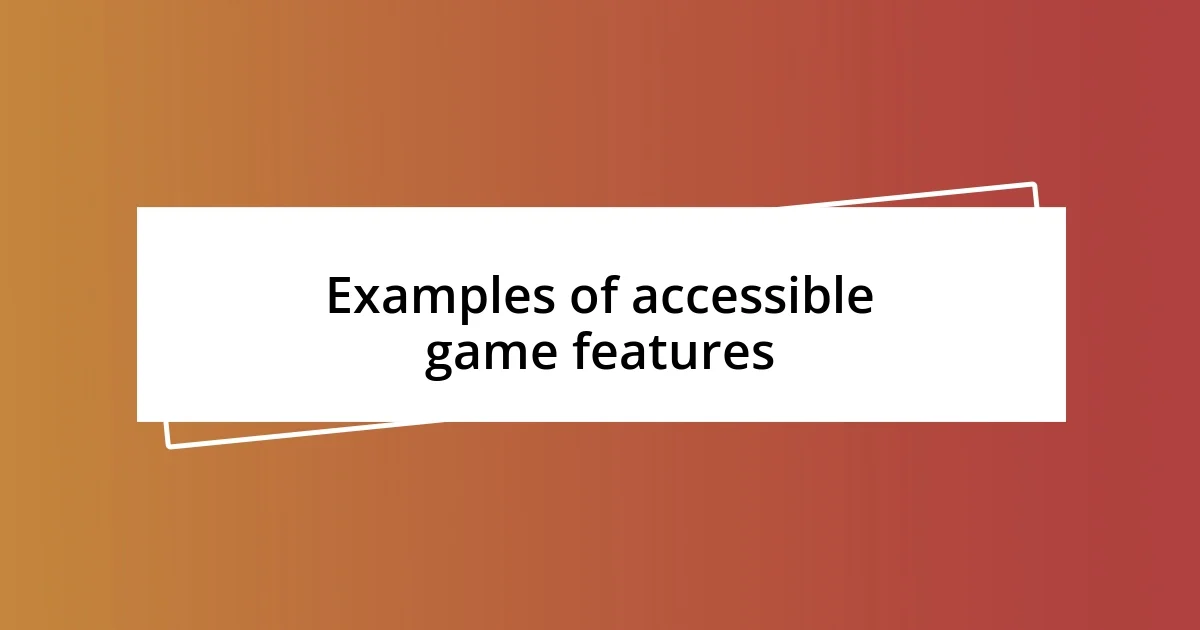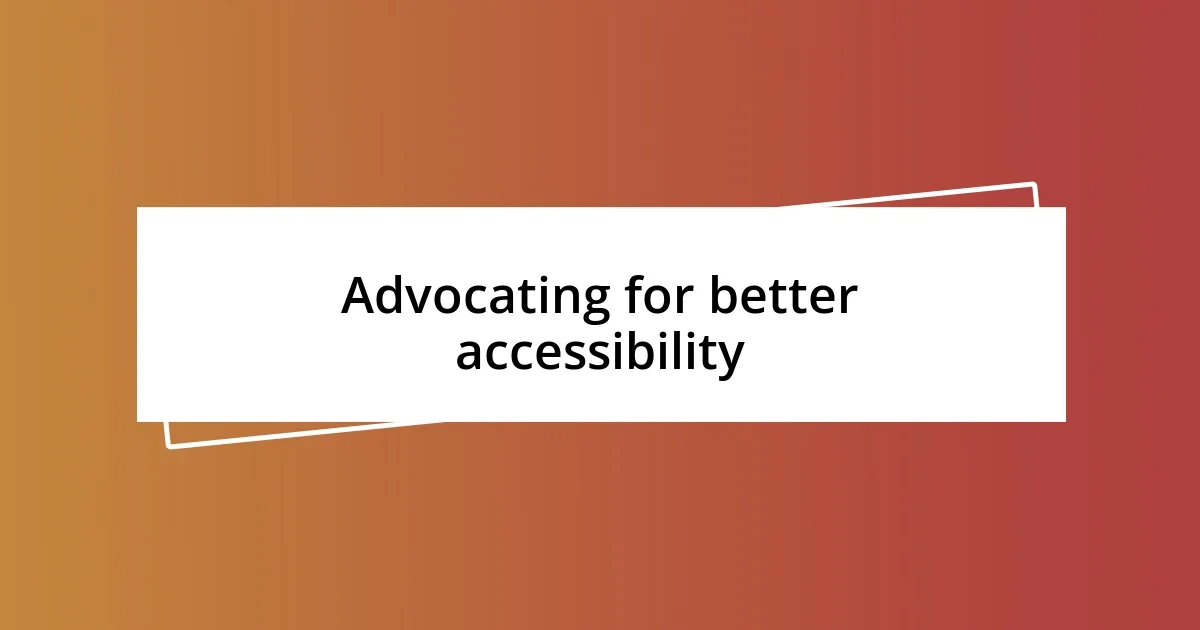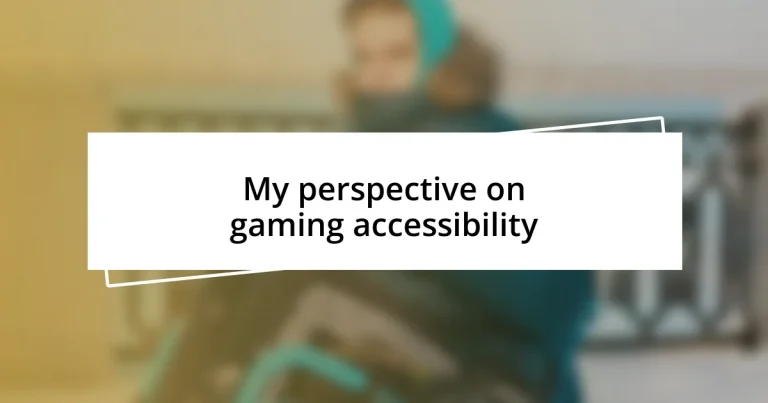Key takeaways:
- Inclusivity in gaming design enhances accessibility, allowing players with disabilities to fully engage and enjoy games, thus enriching the overall gaming experience.
- Key challenges in gaming accessibility include balancing artistic vision with usability, a lack of awareness among gamers, and compatibility issues with adaptive technologies.
- Future trends like AI-driven accessibility tools, wearables, and a focus on mental wellness are set to transform the gaming landscape, making it more inclusive and accommodating for all players.

Understanding gaming accessibility needs
Understanding gaming accessibility needs goes beyond just providing options; it’s about creating an inclusive environment where everyone can enjoy their favorite games. I remember playing a popular RPG with a friend who has limited mobility. Watching him struggle to reach certain buttons made me realize how critical it is for developers to consider alternative control schemes.
Have you ever wondered how much frustration could be avoided if games were designed with accessibility in mind from the start? A friend of mine loves puzzle games, but her visual impairments make it challenging for her. When she discovered an option to customize color contrast and text size, her excitement was palpable. It really reinforced for me that small adjustments can open worlds for players.
Furthermore, I’m often amazed at how adaptive technologies can bridge gaps. The first time I saw a player using voice commands and eye-tracking technology, it struck me how important these innovations are. They truly enable diverse players to engage fully with the gaming community. It’s a powerful reminder that understanding and addressing accessibility needs is a shared responsibility, one that can elevate our collective gaming experience.

Key challenges in gaming accessibility
The challenges in gaming accessibility are often multifaceted and deeply rooted in the design process. I recall attending a gaming conference and hearing a developer share the struggle of balancing artistic vision with accessibility features. It really hit home for me; how often do we prioritize aesthetics over usability? This tension can create barriers, preventing gamers with disabilities from fully immersing themselves in the experience.
Another significant obstacle is the lack of awareness surrounding accessibility options among gamers themselves. I remember a heated debate with friends about a game they loved, where my input on accessibility was met with raised eyebrows. It got me thinking—if the gaming community isn’t collectively advocating for solutions, how can we expect developers to prioritize these features? Building awareness and fostering discussions is essential in driving change.
Moreover, compatibility issues with adaptive technologies can add layers of frustration. I remember the day a friend excitedly upgraded her gaming system, only to discover her adaptive equipment didn’t work as smoothly as before. It’s moments like these that emphasize the need for industry-wide standards and better partnerships between hardware and software developers. Emphasizing seamless integration can mean the difference between an enjoyable gaming session and a frustrating experience.
| Challenge | Description |
|---|---|
| Tension Between Design and Accessibility | Developers often struggle to balance their artistic vision with the need for accessible features, creating barriers for players with disabilities. |
| Lack of Awareness | Many gamers are unaware of existing accessibility options; without community advocacy, the demand for these features remains low. |
| Compatibility Issues | Adaptive technologies sometimes face challenges in compatibility with new systems, leading to frustrating experiences for users. |

Benefits of inclusive game design
Inclusive game design offers significant benefits, not only enhancing the gaming experience for individuals with disabilities but also enriching the community as a whole. I recall teaming up with a visually impaired friend during an adventure game that included audio cues and descriptive narratives. This thoughtful design didn’t just help her enjoy the game; it brought a unique, immersive strategy to our gameplay. It reminded me that when games support diverse needs, they open doors to creativity and collaboration.
Here are some key benefits to consider:
- Wider Audience Reach: Games that embrace accessibility attract a broader demographic, increasing their potential player base.
- Enhanced Player Engagement: Inclusive features create a more enjoyable experience for everyone, fostering stronger community connections.
- Positive Brand Image: Developers recognized for inclusive game design often enjoy a positive reputation, translating to loyal customers and increased sales.
- Fostering Innovation: Designing for accessibility challenges developers to think outside the box, leading to creative features that can benefit all players.
Seeing how inclusive design principles can turn a game into a communal experience really hits home for me. It’s about creating a world where everyone can play and feel valued, regardless of their individual challenges.

Examples of accessible game features
One of the standout features I’ve come across lately is the customizable control schemes in games. I remember vividly when a friend of mine who has limited mobility was able to map actions to her controller in a way that worked best for her. This simple change transformed her gameplay experience, allowing her to feel empowered and enjoy the game without frustration. Isn’t it incredible how a few adjustments can unlock a world of gaming possibilities?
Another great example is text-to-speech functionality. There was one instance in a narrative-driven game where I witnessed a visually impaired gamer fully engage with the storyline through well-implemented voiceover options. Watching their excitement as they navigated through choices was genuinely moving. Features like this do more than enhance accessibility; they enrich the emotional connection players have with the game.
Games like “The Last of Us Part II” really shine with their extensive accessibility options, which include adjustable subtitle size and background color changes. I recall hearing a heartfelt story from a content creator who shared how such features helped his younger sibling, who has hearing difficulties, enjoy the same games they loved together. These moments remind me that accessibility isn’t just for specific groups; it builds bridges and fosters shared experiences between friends and family, making every game night memorable.

Tools and resources for developers
When it comes to tools and resources for developers, there’s a treasure trove available that can significantly enhance gaming accessibility. For instance, I’ve often turned to the Game Accessibility Guidelines website, which offers a wealth of information on best practices. These guidelines helped me appreciate how even minor tweaks in design can make a major impact, really emphasizing how much effort goes into creating accessible experiences.
Another resource that’s proven invaluable is Unity’s Accessibility Plugin. I recall integrating this into my own game prototype and was amazed at how simplifying interface navigation improved interaction for all players, not just those with disabilities. Have you ever considered how much smoother gameplay could be with the right accessibility tools? It’s eye-opening to see that these resources not only cater to specific needs but can also enhance a game’s overall quality.
Lastly, attending industry conferences like GDC or PAX has allowed me to connect with other developers who prioritize accessibility in their game design. Hearing their stories and challenges firsthand has been inspiring. It’s these shared experiences that remind me of the importance of community in fostering an inclusive gaming environment, urging us all to keep pushing the boundaries of what’s possible.

Advocating for better accessibility
Advocating for better accessibility means amplifying voices that often go unheard. I vividly remember a discussion I had with a fellow gamer who relied on adaptive technology to play. Hearing her express the sheer joy of finally tackling a game she had long admired but thought was impossible to play was one of those moments that really drove home the importance of pushing for more inclusive design choices. Isn’t it amazing how game developers can transform lives, making entertainment a possibility for everyone?
Sometimes, I wonder why so many games still overlook accessibility features, especially when they have the potential to reach a broader audience. For instance, I was chatting with a game designer who candidly shared her initial hesitation about integrating accessibility options. But after launching her latest title with those features, the outpouring of gratitude from players changed her perspective entirely. It taught me that not only does advocacy empower those with disabilities, but it enriches the gaming community as a whole—after all, who wouldn’t want to include more players in the fun?
Moreover, the gaming industry has a significant opportunity to champion advocacy by actively engaging in dialogue with players. Recently, I attended a community forum where developers and gamers shared their experiences on accessibility. The heartfelt testimonials of people whose lives were positively impacted by thoughtful game design reminded all of us that inclusivity should be a priority, not an afterthought. Isn’t it our responsibility to advocate for change when we know how powerful these collective experiences can be?

Future trends in gaming accessibility
As I gaze into the future of gaming accessibility, one trend I find especially exciting is the rise of artificial intelligence-driven accessibility tools. Imagine game systems that can adapt in real-time to player preferences, analyzing their interactions and customizing experiences accordingly. I remember testing a beta version of an AI feature that adjusted difficulty levels based on my gameplay style. It was fascinating to see how it could make a game more enjoyable not just for me, but for everyone, including those who might struggle with traditional setups.
Another promising direction is the integration of wearables and smart devices in gaming. I’ve seen prototypes of gloves that translate player movements into in-game actions, particularly for individuals with limited mobility. It makes me wonder, how transformative will it be when such technology becomes commonplace? The accessibility these tools can unlock isn’t just about participation; it’s about elevating the entire gaming experience to one where every player feels truly connected.
Additionally, the ongoing conversation around mental health and wellness in gaming is gaining traction. Developers are beginning to explore how incorporating calming features—like customizable lighting or soundscapes—can make games more inviting for those experiencing anxiety or sensory overload. It reminds me of those moments when I felt overwhelmed while gaming, wishing for an option that could ease my experience. This acknowledgment is a meaningful step toward not only including diverse players, but also nurturing a healthier gaming environment for all. Isn’t it inspiring to think about the potential for games to become safe havens, offering both adventure and tranquility?














